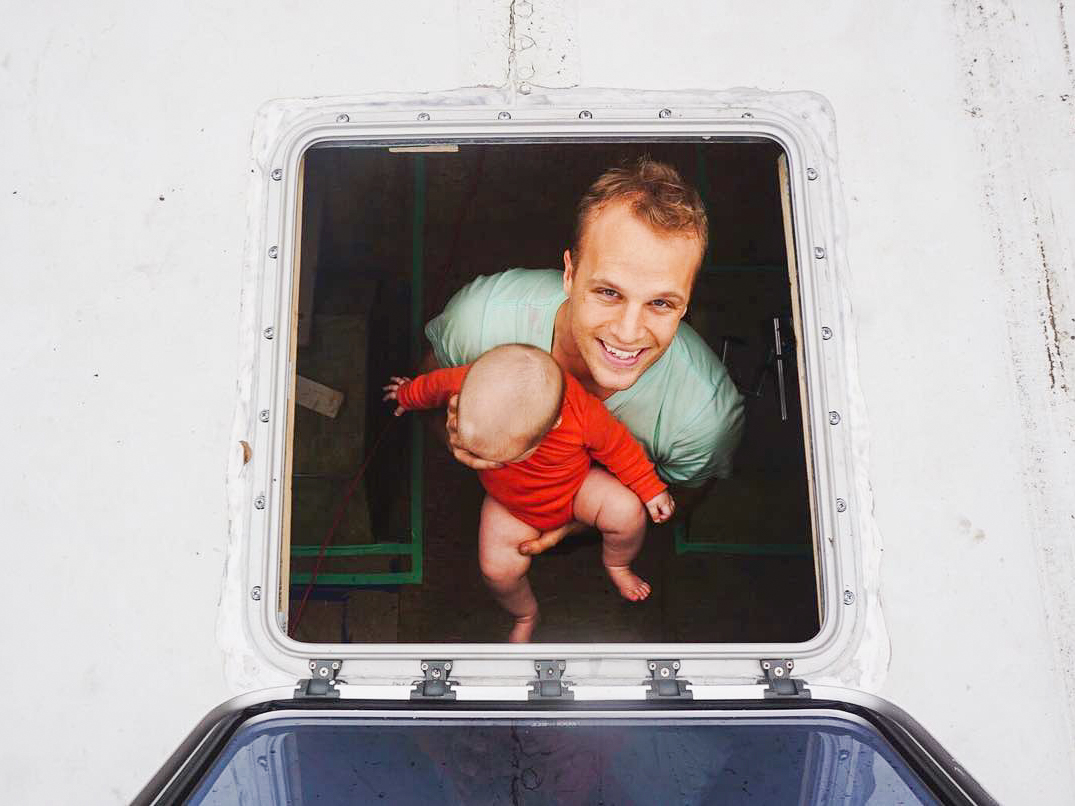Early consideration should be given to anything major that will require you either to seal up or cut holes in your roof. The most common of those items are roof access hatches, skylights, fans, and rooftop air conditioners.
Now the first option is actually to keep your original school bus hatches, ensure they are leak free, and leave them be for roof access, ventilation, and additional light. These hatches pop straight up blocking light rain from entering while still allowing for ventilation and a surprising amount of additional light which you may or may not need depending on how many windows you kept or installed. This would certainly be the cheapest and easiest solution!
Many Skoolie builders however will be well-served by installing 2 or even 3 rooftop ventilation fans. The reason for this is that with a minimal amount of power you can quickly remove and replace the air in your bus in any weather. What this means is if it is hot outside you will be moving the warm air at your head (hot air rises) out of the bus while it is replaced with cooler air that comes from through the cracks and penetrations in/around your floor, doors, and windows. If you have two fans you can also set one to remove air and one to push air in creating a nice circulating effect. This may allow you to live completely free of air conditioning in even very warm climates. The reason for adding more than 2 ventilation fans to your space is to increase airflow in your bus and therefore on your body. A fan blowing on you can make you feel as if the inside of your bus is actually 5 to 8 degrees cooler than it is. This opens up air conditioning free comfort in many hot climates. If you are a person who is comfortable wearing minimal clothing in an 85 degree room, I bet 2 to 3 ventilation fans will let you hit 90 degrees with no trouble, and even higher. Many mobile dwellers who are generally chasing cooler temperatures or not using their bus during hot summer months in the deep southern climates (Florida, Arizona, etc.) can avoid AC entirely with this method. If that is your plan I would not skimp out on the rooftop fans and the absolute best option at the time of writing is the Maxxfan Deluxe made by Airxcel. (I’d recommend this one if you have the budget for it, and this one as a lower price less complicated option) This low-profile rooftop fan has a sensor that closes the fan if it is raining outside while continuing to operate in ceiling-fan mode giving you interior air-flow. It also has 10 speeds and a temperature sensor to adjust when it runs. While there are cheaper options available, most do not have the ability to run while the lid is closed meaning that it won’t operate in the rain, which is a major reason for having a rooftop fan in the first place as all windows will have to stay closed during prolonged heavy rain.
The second consideration for major rooftop holes should be given to rooftop air conditioners. These are incredibly common and installed on almost all RVs and travel trailers and are therefore relatively affordable. Generally a 40 foot bus often visiting hot climates should install at least two and maybe three for comfortable cooling. Some rooftop air conditioners provide for auxiliary heating as well which can take the edge off of a chilly morning but will not replace heaters entirely in colder climates. The problem with rooftop air conditioners however is that the most efficient option still uses between 1,200 and 1,500 Watts while cooling and 1,750 Watts while heating which relegates the use of these AC’s to RV parks while plugged in or to boondocking only while running a generator. While you can feasibly run one or two of these rooftop AC’s off of a monster solar energy system, a large inverter, and a massive Lithium Ion battery bank this is extremely cost prohibitive for most and I don’t recommend trying (but there is another option). These rooftop AC’s while power hungry still make sense for a lot of Skoolie converters and are the easiest way to get air conditioning in your bus. For the savvy builder who insists on running air conditioning off of solar there is an option with the mini-split AC but since it doesn’t require a major hole on the roof we won’t talk about that in this article. More on that here.
The third common roof penetration is one or several skylights. Skylights are a luxury and not essential. Consider however that they may allow you to see trees in the wind from a couch or bed as you lounge or maybe the moon and stars at night. Having a skylight or two makes you feel like you’re outside while you’re inside, kind of like having an abundance of school bus windows. Perhaps if you remove many of your windows you would like to regain that outdoor feeling with skylights. Do consider before you proceed however that any roof penetration is more surface area that you are not insulating and either gaining or losing heat or cold, and it is not space that you can easily cover in solar panels. While we have two skylights in our bus (they replaced our roof hatches) they do contribute to solar gain when in direct sunlight even though they are tinted very dark. Oftentimes we leave them covered. Skylights are definitely a trade-off.
There are many ways to build a skylight whether you make a raised wooden box with a window, skin over a hole in your roof with plexiglass and adhesive with rivets or screws, buy an RV specific plastic dome, or install marine hatches made for boats (which is what we did). If you can integrate your skylight into one or both of the holes that are already in your roof from escape hatches you can save some time because these holes have to be covered anyway. We decided we wanted to keep roof access, keep ventilation, and gain a skylight all in one which is why we patiently searched for a marine hatch that fit our dimensions exactly. This wasn’t an easy task, and most options were incredibly expensive but after months of searching we found a product that was a great fit and was going out of production so was being sold at a discount. It was called the Maxwell WHO62S Check out our Youtube channel Gilligan Phantom for a full tutorial.
Once again this is an area where you will be well-served by using your own creativity, and your own ingenuity to potentially solve several problems at once. In doing so however keep in mind that ventilation, roof access, and additional light may be important to you. We regret not planning for those Maxxfans as we have no significant ventilation that we can keep open while it’s raining.





0 Comments